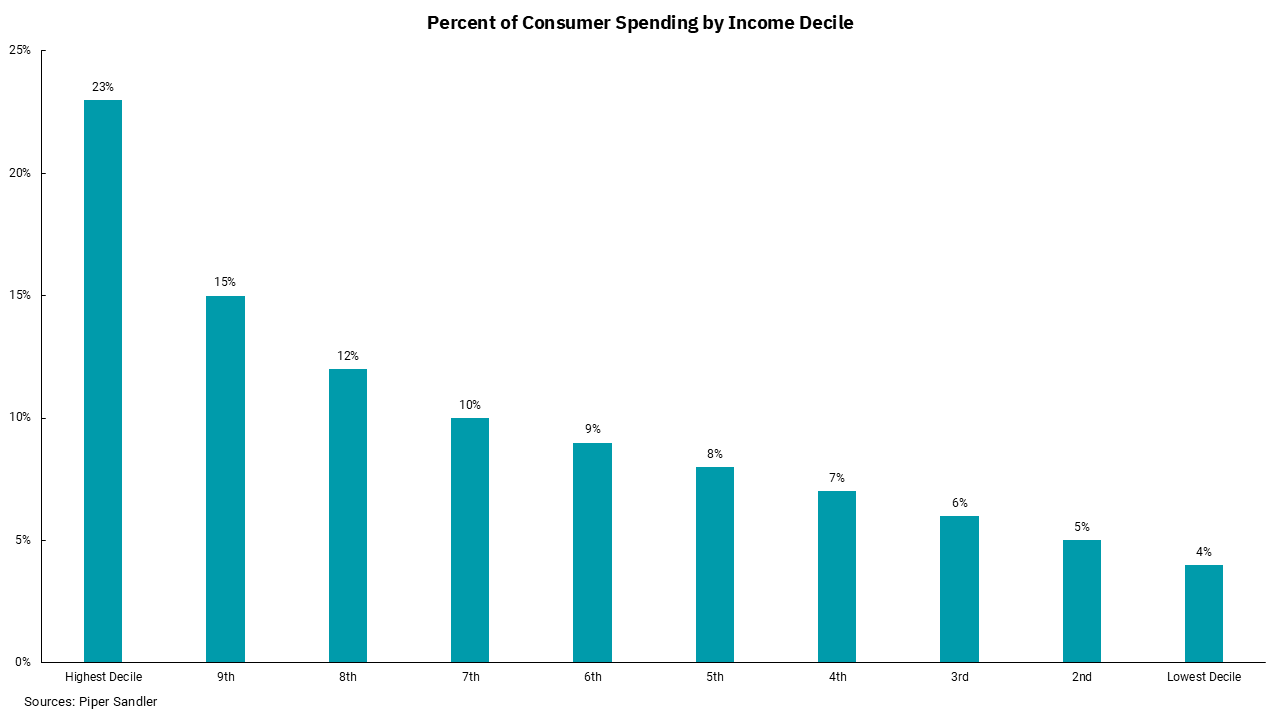
Los servicios no son inmunes a las tarifas, pero en realidad pueden beneficiarse
A medida que los aranceles se afianzan, una mirada a los grupos de ingresos revela cómo puede cambiar el gasto
Ahora que los aranceles del presidente Trump están en vigor, al menos según la actualización más reciente de Truth Social, queríamos volver a visitar al consumidor estadounidense. Una de las razones por las que el impacto de los aranceles es difícil de saber con certeza es que la mayor parte de nuestra economía se basa en los servicios. Por supuesto, los servicios no son inmunes a las tarifas. Por ejemplo, los servicios de piscina, para los cuales se importan productos químicos de China. Dicho esto, los servicios se ven mucho menos afectados directamente que los bienes. Añádase la distribución del coste de los aranceles entre productores, distribuidores, minoristas y consumidores, y podemos ver que es difícil trazar una línea directa entre los aranceles y las medidas de inflación. En conjunto, los aranceles más altos, como los impuestos más altos, afectarán negativamente a la demanda y, por lo tanto, serán, en nuestra opinión, más un problema de demanda que un problema de inflación.
Sin embargo, como casi todos los demás datos económicos, cuando miramos por decil de ingresos, la imagen muestra un nivel variable de impacto. En general, los grupos de bajos ingresos gastan una mayor proporción de sus ingresos en artículos de primera necesidad, lo que los hace más susceptibles a los impactos negativos de los precios más altos.
Nuestro gráfico de esta semana muestra el porcentaje del gasto del consumidor por deciles de ingresos. Debemos esperar que los consumidores de mayores ingresos gasten más, ya que son los que tienen el mayor nivel de ingresos discrecionales. De hecho, podemos ver que el 30% de las personas con ingresos son responsables de la mitad de todo el gasto del consumidor. La capacidad del grupo de ingresos más altos para absorber aranceles más altos podría significar que los aranceles impactan menos el gasto en general. Al mismo tiempo, analizar el gasto de esta manera también ayuda a resaltar por qué la Reserva Federal se centra en devolver la inflación a su objetivo del 2%. La mitad inferior de los asalariados siente los impactos de la inflación de manera más aguda, ya que tienen menos dinero para gastar.
Además, al observar los aranceles y el gasto, hay que considerar otro aspecto de la composición de la economía de los Estados Unidos y la enorme influencia de los consumidores en ella. Los consumidores eligen cómo gastar su dinero. Un consumidor puede optar por no comprar nada ahora que un bien importado cuesta más. Alternativamente, podrían optar por sustituir un bien más barato por el bien ahora más caro. También pueden optar por gastar su dinero en servicios o experiencias en lugar de bienes. Esa última opción, en particular, podría significar que la economía se beneficie de este cambio. La compra de un bien importado significa que al menos parte de ese dinero regresa al extranjero al productor extranjero. Sin embargo, dado que los servicios se ven mucho menos afectados por las tarifas, el gasto adicional en servicios significa que un mayor porcentaje de ese gasto permanece dentro de nuestra economía.
Muchas partes de la economía y el comercio mundiales están cambiando con resultados inciertos. Sin embargo, la historia es clara en cuanto a que si los consumidores estadounidenses tienen dinero, lo gastarán. El mercado laboral y los deciles de ingresos juegan un papel muy importante en cuánto y en qué dinero se gasta, pero mientras el mercado laboral siga siendo positivo, nuestras perspectivas económicas tenderán a seguir siéndolo también.
Obtenga los números entregados en su bandeja de entrada.
Suscríbase (Se abre en una pestaña nueva)